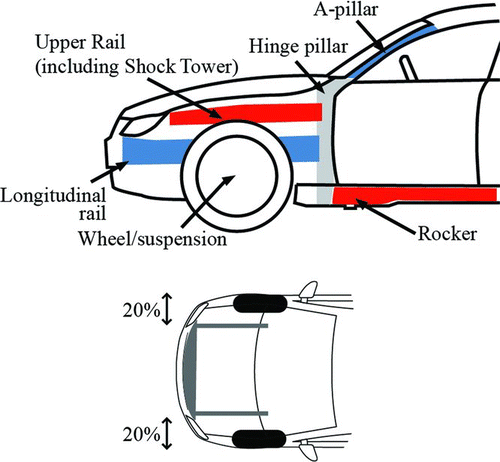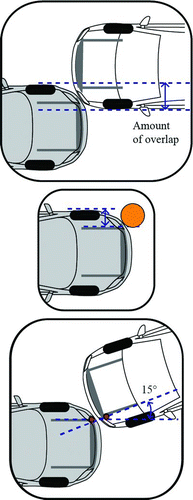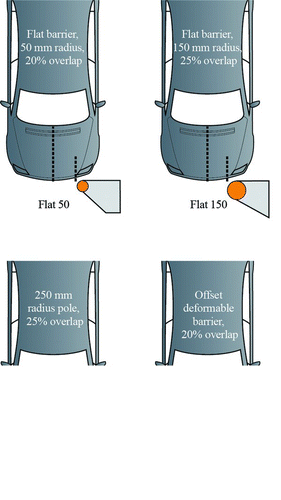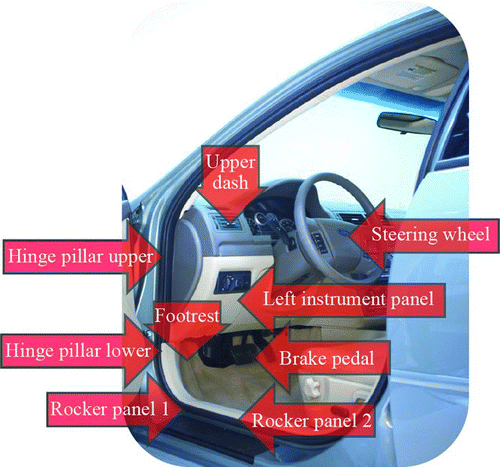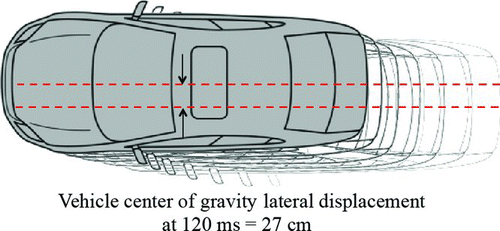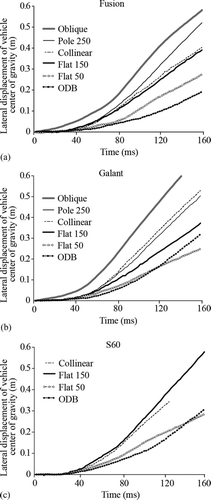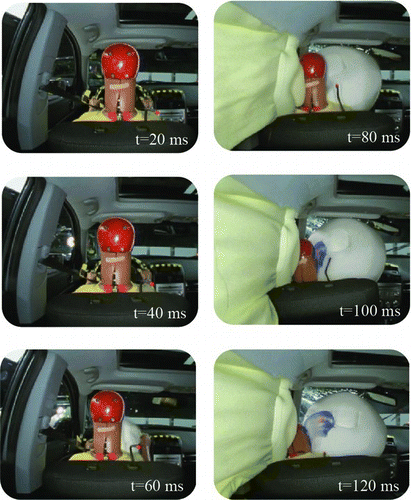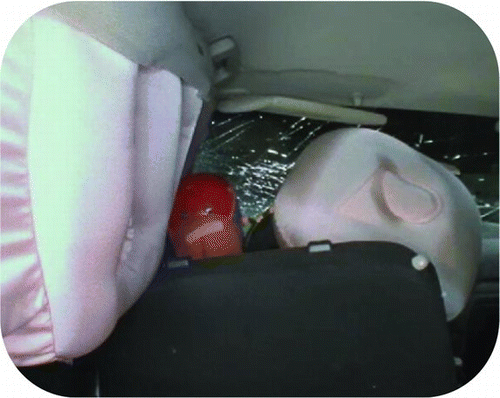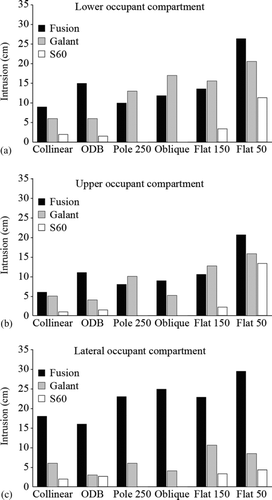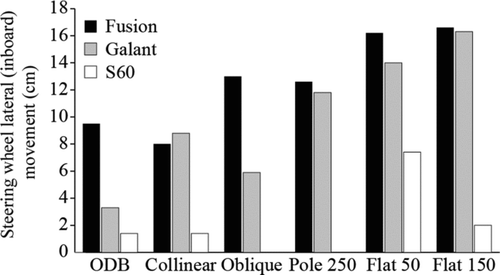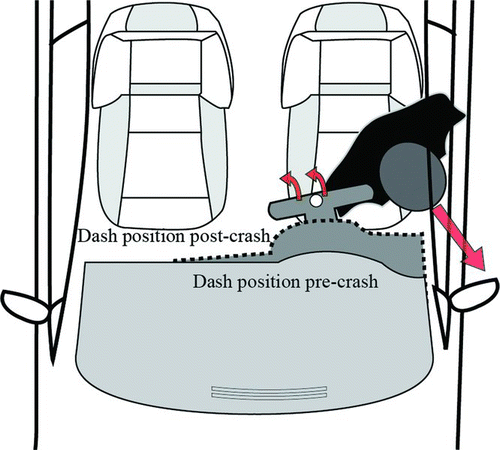Abstract
Objectives: Small overlap frontal crashes are those in which crash forces are applied outboard of the vehicle's longitudinal frame rails. In-depth analyses of crashes indicate that such crashes account for a significant proportion of frontal crashes with seriously injured occupants. The objective of this research was to evaluate possible barrier crash tests that could be used to evaluate the crashworthiness of vehicles across a spectrum of small overlap crash types.
Methods: Sixteen full-scale vehicle tests were conducted using 3 midsize passenger vehicles in up to 6 different test configurations, including vehicle-to-vehicle and barrier tests. All vehicles were tested at 64 km/h with an instrumented Hybrid III midsize male driver dummy.
Results: All test configurations resulted in primary loading of the wheel, suspension system, and hinge pillar. Vehicles underwent substantial lateral movement during the crash, which varied by crash configuration. The occupant compartments had significant intrusion, particularly to the most outboard structures. Inboard movement of the steering wheel in combination with outboard movement of the dummies (due to the lateral vehicle motion) caused limited interaction with the frontal air bag in most cases.
Conclusions: When assessing overall crashworthiness (based on injury measures, structural deformation, and occupant kinematics), one vehicle had superior performance in each crash configuration. This was confirmation that the countermeasures benefiting performance in a single small overlap test also will provide a benefit in other crash configurations. Based on these test results, the Insurance Institute for Highway Safety has developed a small overlap crashworthiness evaluation with the following characteristics: a rigid flat barrier with a 150-mm corner radius, 25 percent overlap, 64 km/h test speed, and a Hybrid III midsize male driver dummy.
Introduction
Common architecture of the front of modern vehicles consists of 2 longitudinal rails, approximately at the height of the bumper (). These rails support the engine and are also used for crash energy management. Current regulatory and consumer information frontal crash tests typically involve interaction between crash barriers and one or both of the frame rails plus the engine. These rail structures are designed so that they absorb crash energy efficiently while minimizing intrusion into the occupant compartment.
The forward ends of the longitudinal rails typically are located inboard of the outer edges of the vehicle width. This arrangement leaves approximately 20 percent of the total vehicle width on either side of the vehicle without energy-absorbing structures. Small overlap frontal crashes are defined as those in which the vehicle is primarily loaded outboard of these rails.
In-depth analyses of frontal crashes with seriously injured occupants indicate that small overlap crashes account for a significant proportion of frontal crashes. Lindquist et al. (Citation2004) found that 34 percent of fatal frontal crashes in Sweden were small overlap. A National Highway Traffic Safety Administration study of crashes with fatalities also identified crashes with limited horizontal engagement as a “priority area for future research” (Rudd et al. Citation2009). In a National Automotive Sampling System study of vehicles that earn a good rating in the Insurance Institute for Highway Safety's (IIHS) 64 km/h 40 percent (moderate) overlap frontal crash test, Brumbelow and Zuby (2009) determined that 24 percent of the cases occurred in small overlap. Small overlap crashes are not only frequent but also pose a greater injury risk to occupants. When compared with large overlap impacts, occupants in small overlap crashes have a “demonstrated increased incidence of head, chest, spine, and hip/pelvis injuries” (p. 147, Hallman et al. Citation2011).
A detailed study of 21 small overlap crashes in the National Automotive Sampling System Crashworthiness Data System found that the small overlap damage pattern resulted from 3 different crash configurations: single vehicle crashes into fixed objects such as trees, posts, and poles (barrier); vehicle-to-vehicle crashes with vehicles going in opposite directions (collinear); and vehicle-to-vehicle crashes with the opposing vehicle striking the case vehicle at a small oblique angle (oblique; Sherwood et al. Citation2009). illustrates these configurations.
Based on the significant percentage of small overlap crashes in which occupants are seriously injured or killed and the fact that there are no current federal safety standards or consumer information tests that address these types of crashes, the IIHS investigated the possibility of adding an evaluation of crashworthiness for vehicles in these types of crashes. The objective of the research was to determine whether a single vehicle-to-barrier test could capture the important characteristics of most real-world small overlap crashes in order to evaluate vehicle crashworthiness in this crash type.
Methods
Sixteen full-scale vehicle tests were conducted with 3 passenger vehicles (2007–2011 Ford Fusion, 2004–2011 Mitsubishi Galant, and 2011–2012 Volvo S60) tested in 6 different crash configurations (). Two of the configurations were vehicle-to-vehicle tests, and 4 were tests into stationary barriers of differing geometry and stiffness. All tests were conducted at 64 km/h.
In the collinear tests, each vehicle was crashed into an identical model (Fusion into Fusion, Galant into Galant, S60 into S60). Overlap in the collinear tests was measured to the line representing the maximum width of the opposing vehicle. All vehicles had an overlap of 22 percent, and this position generally resulted in the wheel of each vehicle being positioned just outboard of the longitudinal rail on the opposing vehicle.
In the oblique tests, a Fusion was the striking vehicle for the Galant test, and a Galant was the striking vehicle for the Fusion. The S60 was not tested in this configuration. The striking vehicle in the oblique tests was aligned 15° counterclockwise from the path of the case vehicle. The oblique orientation makes defining overlap complicated, so the vehicles were aligned with the expectation that small overlap damage would result. This consisted of aiming the target points (intersection of outboard surface of longitudinal rail and bumper bar) at one another.
Table 1 Matrix of crash tests
The IIHS's crash test facility has parallel, opposing runways, and the angles of the runways are not adjustable. To conduct the oblique tests, a guide rail system was anchored to the floor just beyond the position where the vehicle is released from the towing mechanism. The rails consisted of 2 C-channel sections, creating a channel that engaged with roller systems mounted to the vehicle underbody. The case vehicle rail system turned to the right (7.5°), whereas the striking vehicle rail system turned to the left (7.5°). The resulting alignment at impact is equivalent, with respect to the reference frame of the case vehicle, to the case vehicle being struck at a 15° angle. In addition to the roller systems welded to the vehicle, the steering columns for both vehicles were fixed in a neutral position to improve vehicle tracking after exiting the rail system.
Four barrier types were tested (). Two barriers had rigid, flat faces with corner radii. The flat 50 barrier (1533 mm high) had a 50-mm radius and was tested with a 20 percent overlap. The flat 150 barrier (1533 mm high) had a 150-mm radius and was tested at an overlap of 25 percent. The flat face was required to make the barrier wide enough to engage the wheel, as is the case in the majority of real-world crashes (Lindquist et al. Citation2004). A third rigid barrier (pole 250, 250-mm radius, 2144 mm high) was a pole that was wide enough to engage the wheel and was tested with a 25 percent overlap. The S60 was not tested in this configuration. The final barrier (offset deformable barrier, ODB) used a deformable element with the same stiffness, geometry, and height as that used in the IIHS 40 percent (moderate) overlap frontal crash test (IIHS 2012a) but with a vehicle overlap of 20 percent.
Vehicles tested in a small overlap configuration often rotate counterclockwise and potentially could have secondary contacts with barrier supporting structures. The supporting structures in these barrier tests were offset to remove the likelihood of these secondary contacts. To achieve this design in the ODB test, the deformable element was supported by the flat 50 barrier, with the edge of the barrier aligned with the edge of the deformable element.
All crashes were filmed with high-speed cameras and analyzed using motion-tracking software. Each vehicle had pre- and postcrash deformation measurements () at several locations in the occupant compartment. The footrest, left toepan, brake pedal, steering wheel, and left instrument panel locations currently are measured in the IIHS moderate overlap frontal crash test protocol (IIHS 2012a). The resultant deformation was recorded at each of these locations, except for the steering wheel, which was measured only in the longitudinal direction. Longitudinal deformation was measured at the upper dash, upper hinge pillar, and lower hinge pillar points. The upper dash point was located on the leading edge of the upper dash at a point 250 mm outboard from the center of the steering wheel. The hinge pillar points were located on the inner edge of the door frame opening at vertical locations 525 mm above (top) and 75 mm below (lower) the brake pedal reference point. Lateral deformation was measured at 2 points on the rocker panel. Point 1 was measured at the point of maximum lateral deformation, and point 2 was located at a point 500 mm rearward (longitudinal direction) of the brake pedal reference point.
A Hybrid III 50th percentile male dummy was positioned in the driver seat for each test. The dummy was instrumented and positioned according to the IIHS moderate overlap frontal crash test protocol (IIHS 2012a). In the oblique tests, the dummy's torso was supported on each side with foam blocks to minimize pre-impact dummy movement as the cars moved through the rail system. Despite the supports, the vehicle motion prior to impact prevented meaningful analysis of dummy kinematics in these tests.
Results
Vehicle Dynamics
All crash configurations caused significant lateral motion of the test vehicle away from the crash partner. shows a schematic of vehicle movement in the Fusion flat 150 test from t = 0 to 120 ms (every 20 ms). There was almost no vehicle rotation during this portion of the crash. Graphs of the lateral displacement of the vehicle center of gravity for each test, measured using overhead video analysis, are shown in . The oblique test caused the greatest lateral motion, which was expected due to the lateral component of the striking vehicle. The pole 250, flat 150, and collinear tests caused similar amounts of displacement, differing in relative magnitude for each vehicle model. The ODB and flat 50 barriers, with the smallest corner radii, caused the least lateral motion.
Occupant Kinematics
Occupant kinematics are difficult to quantify in full-scale vehicle tests, but it was evident that the lateral vehicle motion caused the driver dummy to undergo significant outboard motion during the crash. shows still images from an onboard camera showing this lateral trajectory (every 20 ms, t = 20 to 120 ms) for the driver dummy in the Galant collinear test.
A critical aspect of occupant kinematics is the interaction with the frontal air bag, and lateral motion of the occupant plays a direct role in this interaction. The resulting contact between the head and air bag, however, is also affected by other factors, including steering wheel intrusion, crash severity, 3-point belt system characteristics, and the presence and design of head and torso side air bags. The current IIHS small overlap rating procedure (IIHS 2012b) categorizes the amount of head protection afforded by the frontal air bag into 3 groups. Stable interaction occurs when the dummy moves forward into a fully deployed air bag and then returns directly to the seat during rebound, with the head and body staying within the original extended perimeter of the air bag. Partial interaction occurs when the head receives significant restraint from the frontal air bag but does not stay within its original extended perimeter or when the air bag provides little additional frontal protection when the dummy reaches maximum forward excursion. Minimal frontal air bag interaction occurs if the head moves into the gap between the door and frontal air bag with little or no restraint from the air bag. The vehicles in these tests afforded the dummies a wide range of head–air bag interactions, as described in .
The level of head protection varied in these tests from the dummy's head completely missing the air bag () to stable air bag interaction. The general trend for each vehicle was that as vehicle lateral movement decreased (moving down the table column), air bag interaction improved. The ODB test caused the most stable interactions. Although the oblique tests were not included because of the vehicle and dummy motion prior to impact, the tests did show significant outboard motion of the dummies and likely would have resulted in the worst dummy kinematics.
There were differing results between the 3 vehicle models. The S60, although not tested in the pole 250 test, had the best results. The Galant had results including minimal, partial, and stable interactions. The Fusion had the poorest air bag interaction; all tests were classified as minimal except for one stable interaction in the ODB test.
Table 2 Driver dummy air bag interaction by crash type for each vehicle
Vehicle Structure
As is consistent with the definition of a small overlap crash, the longitudinal frame rails did not receive significant axial loading in any configuration. Most vehicles had less than 5 cm deformation of the rails, but some did have higher values. In these vehicles, the frame rail was not loaded directly, but collapse of structures rear of the rail effectively pulled the rail rearward. In all tests, the wheel was loaded, either by the barrier or the bumper/engine of the crash partner, and pushed rearward into the lower hinge pillar/toepan and rocker panel. The upper structures (upper rail, shock tower) also were directly loaded and pushed rearward in most tests. Occupant compartment intrusion data are included in , grouped into 3 regions: lower, upper, and lateral. The averaged data for each region are graphed in .
Table 3 Occupant compartment intrusion data (cm)
In terms of average intrusion, the flat 50 test generally caused the highest levels of intrusion, followed by the flat 150 and oblique configurations, although the trends varied somewhat for each vehicle. The collinear and ODB tests caused the lowest levels of occupant compartment deformation. There also was a consistent trend between vehicle models. In all test conditions, and in all regions of the occupant compartment, the S60 had the lowest levels of intrusion. The Fusion and Galant had similar levels of intrusion in the upper and lower regions, although the Fusion had much higher levels of lateral intrusion at the rocker panel.
Lateral movement of the steering wheel () is caused by vehicle structural deformation, although it likely has a greater impact on the performance of the frontal air bag and restraint system. Seven tests had more than 10 cm of inboard movement. The trends were similar to those of the other structural measures, with the flat 50 and flat 150 tests causing the highest values. Results were mixed between the Fusion and Galant tests, whereas the S60 always had the least amount of steering wheel movement.
Occupant Injuries
Dummy injury measures are listed in . Values equal to or greater than 80 percent of the injury assessment reference value are shown in bold. No head or neck injury measures exceeded this 80 percent threshold, and only 2 tests (oblique) had high chest values. The majority of the high injury measures occurred at the lower extremities, and most of these (14 of 17) were recorded on the left side. All knee–thigh–hip (IIHS 2012b) injury risk values were less than 5 percent.
Table 4 Dummy injury measures a
Oblique crashes caused the highest injury values, with 10 measures at or greater than 80 percent of the injury assessment reference value. An oblique test also was the only test with nonextremity measures exceeding this threshold (chest). The remaining high values were distributed across all test configurations, except for the ODB test. The Fusion and Galant tests had similar numbers of high values, whereas there were no high values in the S60 test (although the S60 was tested in 2 fewer tests).
Discussion
All small overlap test configurations caused the vehicles to undergo significant lateral motion. Lateral vehicle motion is critical because of its effects on occupant kinematics, causing the occupant to move outboard during the crash. The vehicles in these crash tests also had consistent structural deformation patterns that caused the steering wheel and frontal air bag to move inboard during the crash. These factors combined to place the dummy's head at risk of injury because the head had less protection from the air bag, and the resulting head trajectory placed it in the region of the occupant compartment with high levels of intrusion ().
Data from the previous study of real-world small overlap crashes (Sherwood et al. Citation2009) were analyzed again to more closely examine injury trends in comparison with findings from crash tests in the current study. Of the occupants with a documented AIS 2+ head injury, 80 percent of the head injuries came from contact with structures on the outboard side of the vehicle (A-pillar, other vehicle, trees, etc.). This pattern is consistent with the head kinematics observed in these tests.
Despite the differences in test configurations (crash partner, approach angle, barrier geometry, barrier stiffness), there were similarities in the load paths and patterns of deformation. The main longitudinal rail was missed, the wheel was directly loaded and pushed rearward into the toepan/hinge pillar/ rocker panel, and the upper structures had additional loading. This loading pattern led to significant intrusion of both the lower and upper regions of the occupant compartment, in both longitudinal and lateral directions. These patterns of vehicle damage were similar to those seen in real-world studies, and occupant compartment intrusion has been identified as the primary injury mechanism in real-world crashes (Lindquist et al. Citation2004; Sherwood et al. Citation2009).
The highest injury measures were recorded at the lower extremities, with a greater frequency of injuries to the left side. Analysis of a previous real-world study of crashes (Sherwood et al. Citation2009) showed the same trend, with 91 percent of occupants having injuries to the left side and only 27 percent to the right side. Despite the risk of head injury due to limited protection from the air bag and a trajectory putting the head near regions with significant intrusion, there were no head contacts and thus no high injury values in the crash tests. This is not necessarily evidence of a low risk of head injury but are limitations of the kinematic fidelity of the dummy, as is seen in real-world studies showing the head to be the second most frequently injured body region. This lack of head contacts is partially due to limitations of the Hybrid III dummy; dummies are known to underestimate the excursions exhibited by humans (Shaw et al. 2000). Forward excursion is particularly important in small overlap frontal crashes because oblique occupant kinematics and inboard steering wheel deformation reduce the ability of the frontal air bag to protect the occupant, putting the occupant at risk of contacting interior components. Although the THOR dummy has been shown to have more biofidelic kinematics than the Hybrid III (Shaw et al. 2000), there were no significant differences in the kinematics between the 2 dummies in a series of small overlap test configurations (Mueller et al. Citation2011).
A critical aspect of addressing small overlap vehicle crashworthiness is that countermeasures or design features show a benefit across a range of crash configurations. Results from this study show that an overall measure of vehicle performance (including vehicle structural response, dummy injury measures, and restraint system assessment) for the 3 vehicles tested consistently ranks the S60 as the best performer regardless of crash configuration. The S60 always had the lowest levels of intrusion, had the lowest levels of injury values (although it was not tested in 2 configurations that included the most severe oblique test), and resulted in the best interaction between the dummy and frontal air bag. These results demonstrate that design features that are effective in a single small overlap test configuration also should show benefit in the spectrum of real-world small overlap crashes.
Based on results from these tests, the flat 150 is the best overall barrier. The corner radius is similar to many of the post/poles/trees near roadways and, unlike the flat 50 and ODB barriers, it provides vehicle lateral motion magnitudes that are similar to vehicle-to-vehicle crashes, although not as high as oblique crashes. Unlike the pole 250, it has sufficient severity to test the integrity of the occupant compartment and the risk of lower extremity injury.
Conclusions
Multiple crash configurations were tested to determine whether a single barrier could capture the most important characteristics of several small overlap crash modes. Despite differences in test configurations, these tests had many similar characteristics and matched trends seen in real-world crashes. The consistent ranking of the 3 test vehicles in terms of overall crashworthiness demonstrated that good design features are beneficial for occupants across a range of small overlap crash configurations. Based on these results, the IIHS has developed a small overlap crashworthiness evaluation test that consists of a moving vehicle tested into a rigid barrier (flat face, 150-mm corner radius) at a speed of 64 km/h and a vehicle overlap of 25 percent. The driver dummy is a Hybrid III 50th percentile male dummy, although consideration will be given to changing to a THOR dummy when it has been finalized and is widely available.
Further test information (barrier drawings, test protocol, etc.) can be found on the IIHS Web site (http://www.iihs.org/ratings/protocols/default.html).
References
- Brumbelow , M and Zuby , D . 2009 . “ Impact and injury patterns in frontal crashes of vehicles with good ratings for frontal crash protection ” . In Proceedings of the 21st International Technical Conference on the Enhanced Safety of Vehicles [book on CD-ROM] , Washington , DC : National Highway Traffic Safety Administration .
- Hallman , J , Yoganandan , N , Pintar , F and Maiman , D . Injury differences between small and large overlap frontal crashes . Paper presented at: 55th Annual Conference of the Association for the Advancement of Automotive Medicine , Des Plaines , IL ; October 2–5,
- Insurance Institute for Highway Safety . 2012a . Moderate Overlap Frontal Crashworthiness Evaluation Crash Test Protocol (Version XIV) , Arlington , VA : Insurance Institute for Highway Safety . Available at: http://www.iihs.org/ratings/protocols/pdf/test_protocol_high.pdf. Accessed December 12, 2012
- Insurance Institute for Highway Safety . 2012b . Small Overlap Frontal Crashworthiness Evaluation Crash Test Protocol (Version II) , Arlington , VA : Insurance Institute for Highway Safety . Available at: http://www.iihs.org/ratings/protocols/pdf/small_overlap_test_protocol.pdf. Accessed December 12, 2012
- Lindquist , M , Hall , A and Björnstig , U . 2004 . Car structural characteristics of fatal frontal crashes in Sweden . Int J Crashworthiness. , 9 : 587 – 597 .
- Mueller , B , Sherwood , C , Arbelaez , R , Zuby , D and Nolan , J . 2011 . Comparison of Hybrid III and THOR dummies in paired small overlap tests . Stapp Car Crash J. , 55 : 379 – 409 .
- Rudd , R , Bean , J , Cuentas , C , Kahane , C , Mynatt , M and Wiacek , C . 2009 . “ A study of the factors affecting fatalities of air bag and belt-restrained occupants in frontal crashes ” . In Proceedings of the 21st International Technical Conference on the Enhanced Safety of Vehicles , Washington , DC : National Highway Traffic Safety Administration . [book on CD-ROM]
- Shaw , G , Crandall , J and Butcher , J . Biofidelity evaluation of the THOR advanced frontal crash test dummy . Paper presented at: 2000 International IRCOBI Conference on the Biomechanics of Impact , Bron , , France September 20–22, 2000
- Sherwood , C , Nolan , J and Zuby , D . 2009 . “ Characteristics of small overlap crashes ” . In Proceedings of the 21st International Technical Conference on the Enhanced Safety of Vehicles , Washington , DC : National Highway Traffic Safety Administration . [book on CD-ROM]
